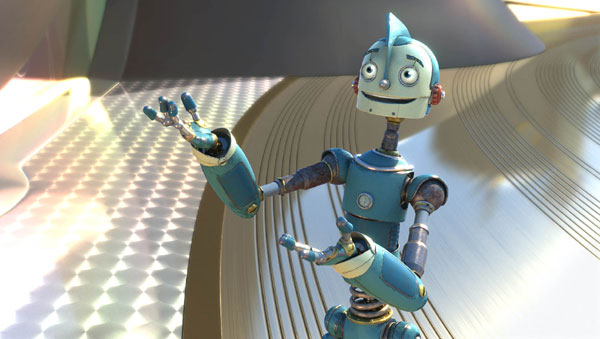Movie review by Greg Carlson
“Robots” is the follow-up to Blue Sky’s “Ice Age,” and it certainly trumps its predecessor in the visuals department. Story is another matter, however, and in that regard, the crew at rival Pixar can breathe a sigh of relief. 3D animation doesn’t necessarily need to be a contest, but the uniqueness of the emerging art form, along with the ever-growing collection of titles, virtually guarantees that wags and fans alike will compare notes with each new movie release. Directors Chris Wedge and Carlos Saldanha certainly must be commended for their eye-popping attention to detail and design, but when the end credits roll, one wishes the overall experience of the movie had resembled kindly protagonist Rodney more than heartless bad guy Ratchet.
Bashing audiences over the head with a handful of simple moral recipes about the need to accept yourself for who you are, “Robots” follows the adventures of Rodney Copperbottom (Ewan McGregor), a would-be inventor eager to peddle his clever creation (a spinning, flying, hyperkinetic coffeepot) to a huge corporation in the bustling metropolis of Robot City. Hooking up with a fast-talking sidekick named Fender (Robin Williams, “turning it on” for the umpteenth time), Rodney discovers that his famous hero Bigweld (Mel Brooks) might be in danger. In “Robots” everything and everyone is a machine, which makes it a trifle odd that Rodney is essentially a robot who builds another robot, but logic is not a priority in a Rube Goldberg-esque place where inhabitants think in terms of mileage as opposed to age.
Drawing much of its inspired look from the sleek vibe of 1950s, “Atomic Age” American industrial style, “Robots” clears another hurdle in the evolution of computer-generated imagery; the texture of metal – which comprises basically every object in the film – is truly wondrous to behold. The character animation (which still owes a debt to incomparable pioneers like Walt Disney and Max Fleischer) is outstanding as well, and adults will enjoy themselves spotting all kinds of familiar objects that have been incorporated into the robots’ world. The primary cast is voiced by all sorts of recognizable talent, including Halle Berry, Greg Kinnear, Amanda Bynes, Jennifer Coolidge, and Drew Carey. Many other thesps (including Paul Giamatti in a giddy, bang-up role that is one of several of the film’s “Wizard of Oz” references) pop up in cameo spots and smaller parts.
Too much of “Robots” stoops to Britney Spears references and bodily function jokes instead of reaching for more sophistication and subtlety. Kids in the audience go nuts for the scatological humor, but the movie depends far too much on the easy and familiar. Particularly vexing are the depictions of Kinnear’s Ratchet and Jim Broadbent’s Madame Gasket. Stock villains, they are too boring to ignite the imagination. Ironically, “Robots” builds itself into the smooth corporate machinery it professes to deny. Gorgeous animation aside, the film would have better served its audience had the dark vision of obsolescence at its core been handled with a lighter touch. For many of the grown-ups, “Robots” works as a parable of Boomer angst (wouldn’t it be nice to keep rebuilding ourselves with replacement parts and shiny upgrades?), but its sentimentality will be recognizable to even the youngest viewers.
